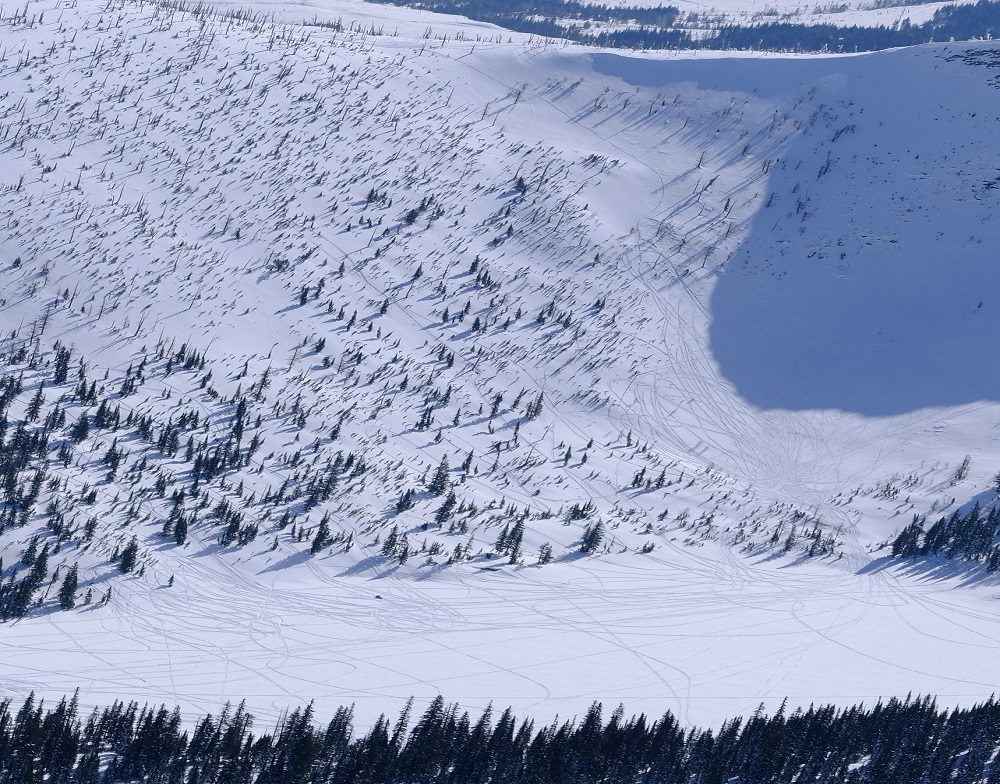Current work in wildlife, rivers, public lands, and climate
Press Releases
Conservation groups find evidence of illegal and harmful motorized use in Northern Idaho
Studies show that OSVs can harass wildlife and increase stress when animals are highly vulnerable by causing them to flee areas at a time when they need to conserve energy until spring, effectively reducing the amount of available habitat.Grizzly bears are susceptible to disturbance, especially during times when they emerge from hibernation starting in late February through April. OSV use may have some harmful effects, such as changing movement patterns, compacting snow and increasing prey competition for Canada lynx. Snowmobile use commonly overlaps with wolverine denning habitat causing females to abandon or move their dens, which decreases their reproductive success. Wolverines have one of the lowest successful reproductive rates compared to other large carnivores, and this is hypothesized as linked to winter energy constraints. Female wolverines select and enter dens and give birth in February to mid-March, and the overlap of winter recreation with this energetically taxing period can harm wolverine reproductive success.
“The reckless and illegal use of snowmobiles and snow bikes in the Selkirk and Idaho Cabinet Mountains has reached an alarming level,” said Paul Sieracki with the Inland Empire Task Force. “Aerial monitoring shows devastating impacts to wolverine, grizzly denning, mountain goat and whitebark pine habitats.”
The monitoring results come at a time when the Forest Service is considering designating areas and trails for winter motorized use. On March 22, the Idaho Panhandle National Forest announced a 30-day comment period for a project that officially authorizes snowmobiles, snow-bikes and other OSVs to access more than 1,046,000 acres in northern Idaho. The draft environmental assessment for the Kaniksu Over-Snow Vehicle Use Designation Project would allow vehicles on more than 1,180 miles of ungroomed trails and 450 miles of groomed trails. The comment period ends April 28, 2023.
“The Forest Service must not sacrifice grizzly bears, wolverine and sensitive wildlife like mountain goats just to provide play areas for high-powered winter vehicles.” said Adam Rissien, ReWilding Manager with WildEarth Guardians. “With dwindling snow-pack and earlier melt due to the climate crisis, the agency should be expanding protections from harmful motorized recreation, not rewarding illegal and harmful use.”
The groups note that until now, northern Idaho’s Cabinet Mountains have not been aerial surveyed for snow tracks, and the monitoring results show clear violations of the Endangered Species Act and other laws that protect these fragile ecosystems.
“Being able to go up on the Lighthawk flight was a rare opportunity to see whether winter recreationists were keeping out of grizzly bear denning habitat. They aren’t,” said George Gehrig, volunteer photographer and creator of the ecoregional, transborder Northern Rocky Mountain Biodiversity Challenge. “The Forest Service seems unwilling or unable to stop ongoing illegal use, and without adequate enforcement, the Kaniksu OSV Plan won’t be worth the paper it’s written on.”
“The Upper Pack River area, in particular, must be immediately protected from further impacts before irreparable damage is done,” said Sieracki. “The Selkirk recommended wilderness area must not be allowed to become a playground for lawless thrill-seekers.”

Evidence of disruptive snowmobile use in the Upper Roman Nose Lake and Apache Ridge areas on the Idaho Panhandle NF. The area provides important habitat for denning grizzly bears, wolverine and wintering mountain goats. Picture by Inland Empire Task Force during flight provided by LightHawk.